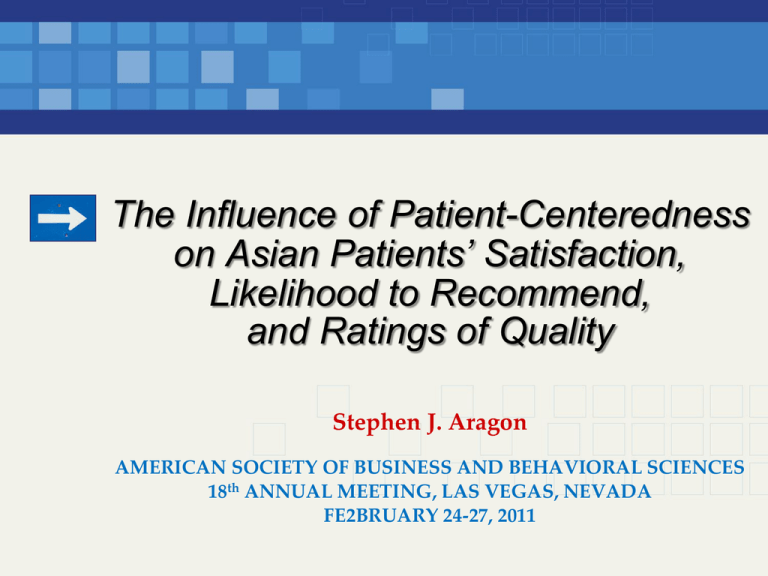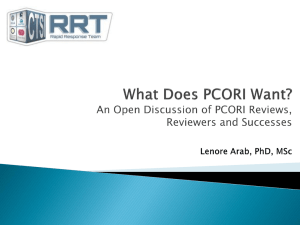
The Influence of Patient-Centeredness
on Asian Patients’ Satisfaction,
Likelihood to Recommend,
and Ratings of Quality
Stephen J. Aragon
AMERICAN SOCIETY OF BUSINESS AND BEHAVIORAL SCIENCES
18th ANNUAL MEETING, LAS VEGAS, NEVADA
FE2BRUARY 24-27, 2011
Non-Conflict of Interest Certification
The research upon which this presentation is based was sponsored by
The National Institutes of Health National and Center on Minority
Health and Health Disparities through The Provider PatientCenteredness and Disparities Outcome Measurement Initiative
(NIH/NCMHD-1P20MD002303-04).
I certify that neither I nor any member of my family has a material
financial relationship, bias or ethical conflict, which will prevent me
from making this presentation solely on the basis of its merits.
Stephen J. Aragon, PhD, MHA
Principal Investigator
2
Presentation
1.
The Grant
2.
The Underlying Theory
3.
Some empirical evidence supporting patientcenteredness’ influence on outcomes
4.
Closing comments and answer questions
3
The Provider PatientCenteredness and Disparities
Outcome Measurement Initiative
(NIH/NCMHD-1P20MD002303-04)
The Provider Patient-Centeredness and
Disparities Outcome Measurement Initiative
5-year $700,000 grant funding empirical research, which will
be translated into outcomes to help improve quality and
reduce disparities for minority patients, women, and children
5
Specific Aims
1)
Establish that patient-centeredness is an underlying
ability of healthcare providers
2)
Establish that the patient-centeredness of health
providers affects the outcomes of minority patients,
women, and children
3)
Establish that the effect of provider patient-centeredness
on outcomes is stable across patients, providers, and
settings
6
Specific Aims
4)
Develop a patient-centeredness graduate course for
medical, nursing, and allied health students
5)
Develop a patient-centeredness certificate program for
health providers
6)
Develop an inventory for measuring the patientcenteredness of health providers
7)
Increase the number of minority researchers involved in
patient-centeredness research
8)
Conduct annual patient-centeredness symposiums
7
The Primary Provider Theory
An evidence-based generalizable theory of
how the patient-centeredness of health
providers affects desired outcomes
The Primary Provider Theory
Developed from observations and interviews with
patients in hospitals and medical practices
It is exclusively based on principles that favor
patients in healthcare encounters
9
Theory Principles
1.
Clinical competency is a necessary but insufficient
condition of desired health outcomes.
2.
Desired outcomes require more than clinical competency
alone, because delivery of medical care requires interaction
with patients.
3.
The source of patient-centered care is patient-centered
providers, not proclamations, policies, or procedures.
10
Theory Principles
4.
Patient-centeredness is the ability of health providers that
affects the quality of their interaction with patients.
5.
Providers are solely responsible for the quality of their
interaction with their patients.
6.
Patients and their families value both the patientcenteredness and clinical competency of providers.
7.
Providers who are patient-centered and clinically competent
are more likely to achieve desired outcomes.
11
Theory Principles
8.
Healthcare providers must, above all else, protect the best
interests of their patients first.
9.
The patient-centeredness of healthcare providers is more
important than profit in any single health encounter.
10.
Patients are the best judges of the patient-centeredness of
their providers.
12
Patient-Centeredness IQ
High
Low
Empathetic, communicative,
interested in patient’s feelings
Aloof, uncommunicative, less
interested in patient’s feelings
Tactful, skilled in relationships
with patients
Less tactful and skilled in
relationships with patients
Grasp patients’ needs,
preferences, values, and
concerns
Less concerned with patient’s
needs, preferences, values, and
concerns
Protect patient’s best interests
above all else
Subordinate patient’s best
interests to other interests
Earn patients’ trust, satisfaction,
confidence, high ratings, loyalty
Tend not to earn patients’ trust,
satisfaction, confidence, high
ratings, loyalty
*Note: High patient-centeredness ability reflects emotional stability, agreeableness, conscientiousness, ethical behavior, interpersonal
sensitivity, while low ability reflects more dysfunctional dispositions or relationship derailers, e.g., moody, inconsistent, cynical, distrustful,
indifferent, prejudices, critical of others, etc., and personality disorders.
The Primary Provider Theory
Patient
Centeredness
of Waiting
Patient
Centeredness
of Provider
effect
Patient
Centeredness
of Associates
Patient
Outcomes
Empirical Evidence
Supporting the hypothesis that patientcenteredness is an ability of healthcare
providers that affects the quality of their
interaction with patients and related
outcomes
Does Pediatric PatientCenteredness Affect Family
Trust?
Aragon, S. J., McGuinn, L., Bavin, S. A. and Gesell, S. B., Does Pediatric
Patient-Centeredness Affect Family Trust? Journal for Healthcare Quality,
32: 23–31, May/June 2010.
http://onlinelibrary.wiley.com/doi/10.1111/j.1945-1474.2010.00092.x/full
Theory Sub-Proposition
e
e
pcm
pcm
pcm
pcm
e
pcm
e ff
ec
t
effect
t
ec
e ff
EFFECT
PRIMARY
PROVIDER
WAITING
TIME
e
CT
EF
FE
FE
C
CT
FE
EF
EF
T
pcm
EF
FE
C
e
T
ef fe
EFFECT
PROVIDER
ASSOCIATES
e
DESIRED
OUTCOMES
ct
pcm
e
pcm
e
pcm
e
effect
ef f
ec
t
t
ec
eff
effect
e ff
ec
t
e
effect
t
ec
eff
e
ef f
ec
t
e
pcm
pcm
pcm
e
e
e
pcm = patient-centered measures
e = measurement error
17
Theory Sub-Proposition
Patient
Centeredness
of Provider
effect
t
ct
eff
ec
fe
ef
t
ec
eff
Patient
Centeredness
of Associates
Patient
Centeredness
of Waiting
effect
Patient
Outcomes
18
Research Questions
Does nursing patientcenteredness affect Medicaid
patient satisfaction?
v1_1
e1
1
N1
a1
v2_1
e2
v5_1
e3
1
1
N5
a2_1
a4_1
N3
1
If yes, how much?
e4
1
vv
v1
_1
Patient
Centeredness
of Nurse
b1
_1
N4
Medicaid
Patient
Satisfaction
a3_1
Is the influence of patientcenteredness stable across
samples?
v6_1
_1
1
O3
O4
1
1
e7
e8
v3_1
v4_1
19
Measures
Nursing PatientCenteredness
e1
1
N1
a1
v2_1
e2
v5_1
e3
1
1
N5
a2_1
a4_1
N3
1
v6_1
e4
1
_1
vv
v1
_1
Patient
Centeredness
of Nurse
b1
_1
N4
Medicaid
Patient
Satisfaction
a3_1
N1 Friendliness and courtesy
N5 Kept patient informed
N3 Attitude toward requests
N4 Amount of attention
v1_1
1
O3
O4
1
1
e7
e8
v3_1
v4_1
20
Measures
Medicaid Patient
Satisfaction
03 Likelihood of
recommending hospital
04 Overall rating of care
e1
1
N1
a1
v2_1
e2
v5_1
e3
1
1
N5
a2_1
a4_1
N3
1
v6_1
e4
1
_1
vv
v1
_1
Patient
Centeredness
of Nurse
b1
_1
N4
Medicaid
Patient
Satisfaction
1
v1_1
a3_1
O3
O4
1
1
e7
e8
v3_1
v4_1
21
Samples
v2_1
e2
Total N = 605
Group 1, N = 294
Group 2, N = 311
e3
1
v4_1
e4
1
v5_1
e5
v8_1
e6
1
CP3
a1
_1
a 3_1
CP4
CP5
vvv1_1
a2 _1
_1
a4
Patient
Centeredness
vv1_1
e01
b1
_1
1
CP6
Family Trust
CP9
SEX
a5_1
1
v3_1
CP2
_1
1
1
CP1
a6
Random samples
e1
1
1
v1_1
CP10
1
1
e03
e04
v6_1
v7_1
22
Results (standardized)
CP1
.90
CP2
e2
CP3
e3
.89
5
.9
CP5
2.
e01
.9
5
.89
.82
e6
CP6
Family Trust
SEX
Chi Sq = 64.87, df = 69, p = .62
RMSEA = .00, p = 1.00
CFI = 1.00
2 = 64.87, df = 69, p = .619; RMSEA = .000, p = 1.00; CFI = 1.00; R 2
= .89
p < .001
.01
CP9
.91
.91
1.
Patient
Centeredness
CP4
e4
e5
It explained 89% of family
trust.1
.96
.94
.91
.9
5
.92
.9 6
2
.87
e1
.9 3
The model fit. Pediatric
physician patientcenteredness significantly
affected (.95) family trust.1,
.9 1
CP10
.83
e03
e04
23
Results (standardized)
.87
The effect was stable
across both samples.3,4
CP1
e1
.9 3
.90
CP2
e2
.9
5
.92
.89
CP4
e4
Gender had no significant
effect on family trust.5
CP5
p < .001
4.
2 = 13.94, df = 17, p = .671
5.
P > .62
e01
.9
5
.89
.82
e6
CP6
Family Trust
.01
SEX
Chi Sq = 64.87, df = 69, p = .62
RMSEA = .00, p = 1.00
CFI = 1.00
CP9
.91
.91
3.
5
.9
.91
e5
Patient
Centeredness
.94
.9 6
The model held versus the
competing model.4
.96
.9 1
CP3
e3
CP10
.83
e03
e04
24
Conclusion
The patient-centeredness of pediatricians
significantly positively influenced their (1) care
behaviors with patients and (2) increased family
trust, confidence, and the likelihood to recommend
the pediatrician to others by .946, .904, and .863
across both samples.
25
Closing Comments
Closing
DHHS established the reality of wide-spread
health disparities the first National Healthcare
Disparities Report almost 40 years ago.
The most recent Report states "disparities related to
race, ethnicity, and economic status still pervade
the American health care system."
Somehow all the science and technology, splendid
hospitals, prestigious medical schools and board
certified physicians are not enough. Something
clinical competency is needed.
Closing
Patient-Centeredness is the ability of healthcare
providers that affects the quality of their
interaction with patients and related outcomes.
Patient-Centeredness is a measurable, teachable,
and can improve quality and outcomes.
The Primary Provider Theory is an evidence-based
measurement model for designing patientcenteredness outcome studies.
Closing
The Theory’s robustness and stability established
across:
1.
2.
3.
Patients - African American and Black, American Indian and
Alaskan Native, Asian, family practice, cardiology, dental,
obstetrical, medical, surgical, emergency, across gender, time,
age, and insurance type
Providers - physicians, nurses, mid-level practitioners, and
dentists
Settings - hospitals, medical practices, clinics, and emergency
departments
29
Thank you!
Grant’s Significance
1.
Offers another path to help prevent and overcome
disparities.
2.
Provides empirical evidence that the patient-centeredness
of providers affects desired outcomes for minority patients,
women, and children.
3.
Will establish the yard stick for measuring the patientcenteredness of providers for assessment, selection, and
training to improve quality.
31
Significance
4.
Will help increase the number of minority patientcenteredness researchers.
5.
Can help increase the number of patient-centered
providers over time.
32
Empirical Investigations
1.
How the patient-centeredness of obstetrical nurses affects
the satisfaction of Medicaid OB patients
2.
How the patient-centeredness of physicians and nurses
affects the satisfaction of Black and African American
female medical, obstetrical, and surgical inpatients
3.
How physician and nursing patient-centeredness affects
male American Indian and Alaskan Native patient
satisfaction, likelihood to recommend, and ratings of care
33
Empirical Investigations
4.
How nursing patient-centeredness affects the satisfaction
of Black and African American female Medicare patients’
satisfaction
5.
How the patient-centeredness of physicians affects Asian
patient satisfaction, likelihood of recommending the
hospital, and ratings of care
6.
How the patient-centeredness of nurse practitioners affects
patient trust, confidence and likelihood to recommend
across national random samples of pediatric, internal
medicine and family practice patients
34
Empirical Investigations
7.
How the patient-centeredness of cardiovascular physicians
affects patient trust, confidence, and loyalty
8.
How the patient-centeredness of nurse practitioners,
waiting time, and nursing affects the likelihood to return of
female family practice patients
9.
How the patient-centeredness of pediatricians affects
family trust, confidence, and likelihood to recommend the
pediatrician
35








